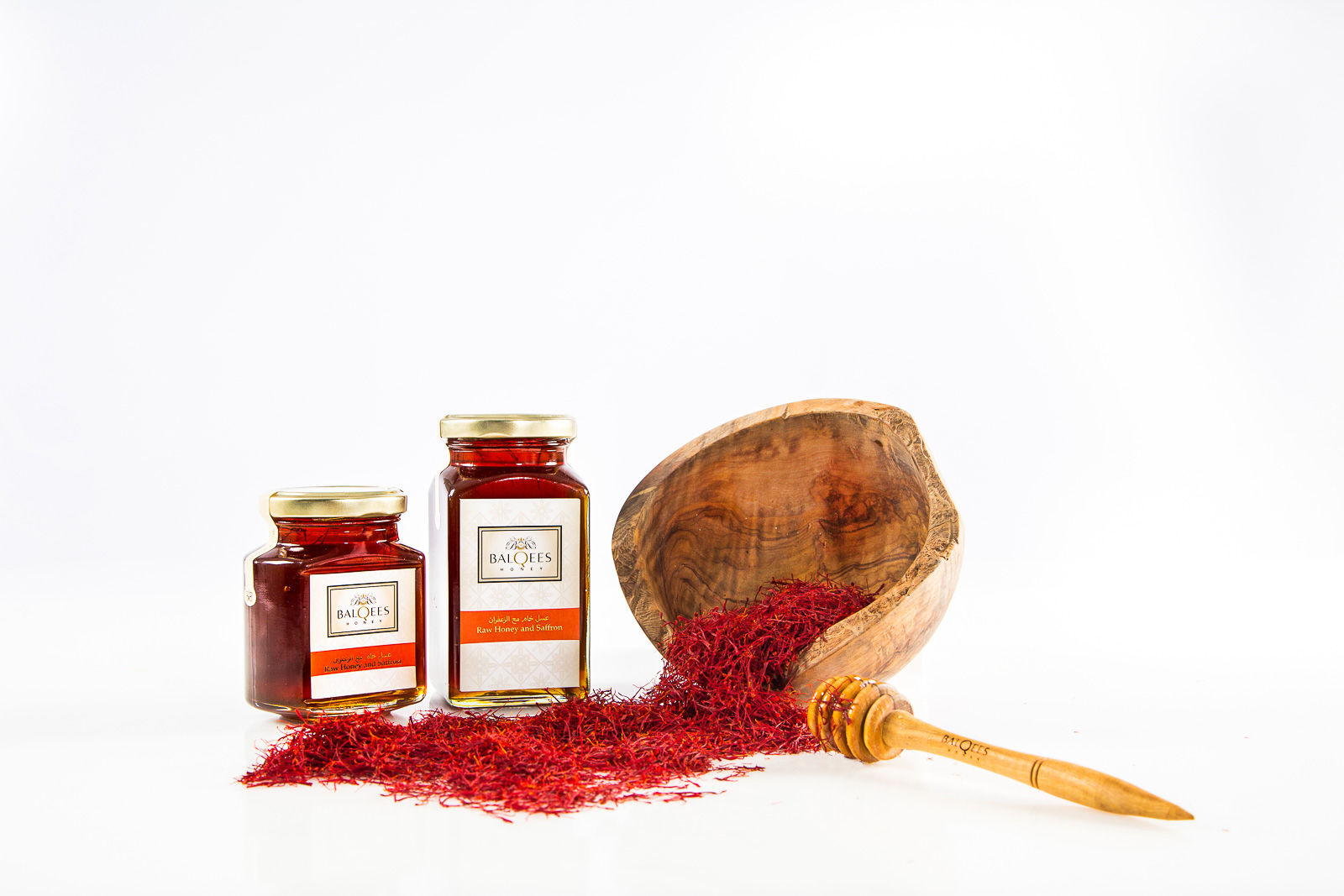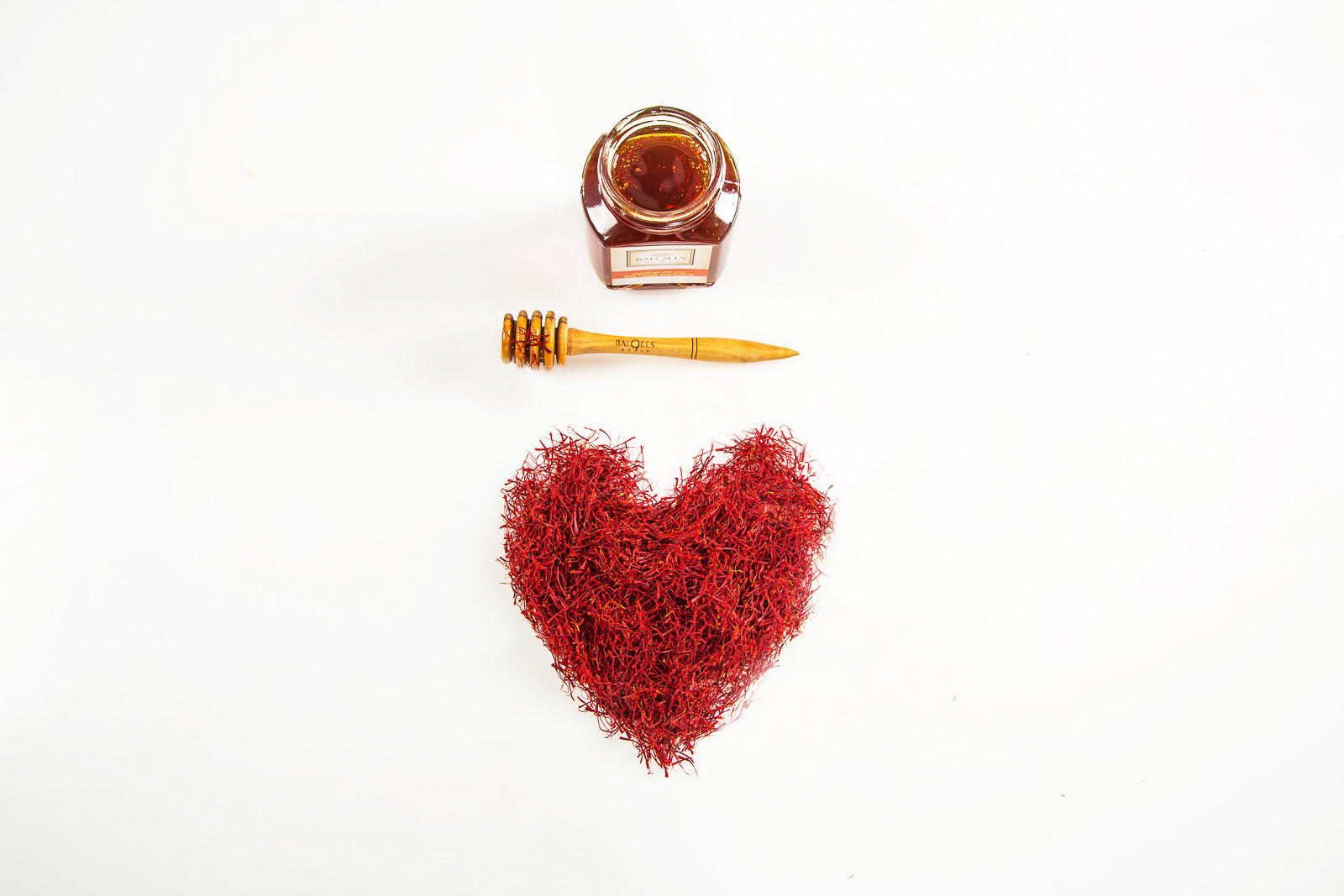
Blending a spice woven into the history of the Middle East with Balqees Raw Yemeni Sidr Do’ani made absolute sense to Riath (Balqees founder) when he was creating our saffron and raw honey fusion. As well as the taste, we explore why this precious substance became so prized and investigate its lesser known health benefits.
Saffron is a highly valued spice and one of the most expensive culinary ingredients in the world. It's from the Crocus family and the word crocus means thread in Greek, referring to the appearance of its stamens. Saffron originates from the Arabic word, Zafaran.
This special spice has been around for a thousand years and has a plethora of uses. The best quality saffron has a deep red colour and is often referred to as ‘the red gold’. A high price is placed on this ingredient because of the amount of labour that goes into producing its threads. It takes 80,000 flowers to produce 453 grams (1 pound) of saffron. The stigmas of the flower are gathered only at dawn as the violet-blue flowers open, in order to retain their aroma and natural goodness. Every flower has three delicate crimson stigmas in the centre which are placed on a special sieve and cured over heat to amplify their flavour.
The saffron crocus thrives best in warm, humid climates and interestingly, these stigmas are the pollen receptors, capturing tiny grains of pollen as the flowers are visited by bees seeking their nectar. That’s why there is such a strong affinity between the flavours of honey and saffron; it carries a honey aroma and a delicate musky, earthy taste that is used to add flavour and its golden colour to foods.
Saffron has been cultivated for thousands of years to be used in medicines and perfumes mostly in Iran, Spain and India. Saffron is also endemic to Greece and other Mediterranean regions and it is cultivated in a limited amount in countries like the US, Turkey, Italy, Pakistan, France. Iran produces more than 95% of the entire world supply.
Helps ease stress and anxiety and promotes mental wellbeing
Various studies have shown that the stigma of the plant, the actual saffron, and its petals can improve mood. Safranal and crocin, two compounds present in saffron, regulate neurochemicals such as dopamine, serotonin, and norepinephrine which help reduce symptoms in mild to moderate depression. It affects the endocrine system and helps reduce stress and anxiety. Since ancient times, people have been using saffron to relax the mind and promote peaceful sleep due to its sedative properties. Saffron also helps with learning and memory retention.
Helps prevent Macular Degeneration
Macular degeneration, America’s leading cause of blindness, is an age-related condition caused by degenerating cells in an area of the eye known as the macula. Crocin and crocheting found in saffron can help prevent cell damage and delay the age-related decline in the cells of the eye as a whole.
Skin benefits
Loaded with antioxidants keeping the skin supple and radiant, a mixture of saffron and honey applied to the skin can help reduce the effects of acne, fade scars, dark spots, and other skin blemishes. Saffron also has vitamin B2 which can help heal chapped lips.
Aids breathing and respiratory ailments
It can reduce coughing and symptoms of the common cold. It acts as an expectorant which loosens the phlegm from the lungs and throat. Saffron also has the quality to act as an anti-inflammatory substance as well as a stimulant. Both qualities can be beneficial against asthma (always consult a doctor first if you have difficulty breathing).
Relieves pain
As saffron is anti-inflammatory it can help relieve pain in some instances. Saffron also carries antiseptic qualities and the compound safranal that can relieve toothache and even provide a mild sedative effect. It is used in some countries as a relaxant and natural sleep aid.
Good for digestion
Saffron is known for treating upset stomachs and flatulence. It is good for liver health and helps remedy constipation and bloating.
If you have health concerns or are showing symptoms always seek advice from a medical professional.
Balqees uses the highest quality Iranian saffron which we blend into Sidr honey for about an hour. We then leave it to infuse for at least 48 hours to allow the release of all the amazing essential oils and to really intensify the beautiful saffron aroma with the raw honey.
This special fusion combines all the beneficial effects of saffron with the qualities of raw honey. The nectar for the raw honey is from the blossom of the Sidr trees which grow in the mountains around South Yemen’s Do’an valley (Wadi Do’an) in the remote desert region of Hadramout, located in the South Arabian Peninsula. Combined with the saffron it’s medium to dark amber in colour, smooth and viscous, rich and moderately thick. There is a slight earthiness and nuttiness in its flavour.

Spice up your morning porridge and drizzle this luscious, fragrant honey over it. It goes well with mild or sharp cheeses. Brush it over stone fruit, like apricots, or spoon over pancakes and waffles with buttermilk ice-cream. Add it to labneh or Greek yoghurt for a healthy breakfast. For the not so healthy, luqaimat, an Emirati sweet (fried dough balls that are often eaten for breakfast) soaked in saffron-infused raw honey, one of our favourites here at Balqees.
For savoury dishes, its works well as a glaze for grilled chicken and its enigmatic flavour complements smoked meats and fish. Try coffee spiced with saffron honey fusion and cardamom for a soothing and heart-healthy drink. If you add saffron honey fusion with cinnamon to whole milk or yogurt, you get a simple version of the Indian drink, lassi.
Note: Always allow hot drinks to cool a bit before adding raw honey to get the maximum health benefits (as heat can destroy some of them).
*Sources
Found this interesting? Never miss a post – sign up for our regular newsletter packed with exclusive offers, recipes, health news and much more.
RiathSign up for exclusive offers, recipes and the latest raw honey news.